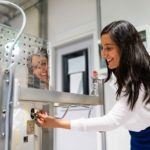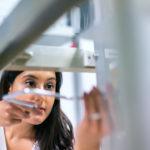Profile
Vinita Marwaha Madil
Curriculum Vitae
-
Education:
Buckland Primary School, Surrey (1990), Our Lady Immaculate RC Primary School (1990-1998), Tolworth Girls’ School (1998-2005), King’s College London (2005-2008), International Space University (ISU) (2008 & 2009-2010), Cranfield University (2008-2009).
-
Qualifications:
BSc Mathematics and Physics with Astrophysics at King’s College London, Space Studies Programme (SSP) at International Space University (ISU-2008), MSc Astronautics and Space Engineering at Cranfield University, MSc Space Management at International Space University (ISU)
-
Work History:
Project Manager and Astronaut Health Lead at Mission Control, Space Operations Engineer (ESA – via TERMA B.V.), Founder – Rocket Women, PR & Communications Team Co-Lead at Space Generation Advisory Council (SGAC) in Support of the UN Programme on Space Applications, Engineering Manager-Intelligent Transportation Systems at Miovision Technologies (Canada), ISS Payload Operations Engineer at DLR (German Aerospace Centre), Trainee at European Space Agency (ESA), Research Assistant at King’s College London.
-
Current Job:
Project Manager & Space / Astronaut Health Lead at Mission Control Space Services / Founder at Rocket Women
-
Employer:
Mission Control Space Services
Rocket Women
-
About Me
I'm a space engineer working at Mission Control on lunar exploration missions and astronaut health projects. I previously worked at the European Space Agency (ESA) through TERMA B.V. on future human spaceflight missions. I'm also the Founder of Rocket Women, which aims to inspire the next generation of women in STEM!
-
Read more
My name is Vinita Marwaha Madill and I’m a space engineer working at Mission Control in Ottawa, Canada. I lead astronaut health and robotic lunar exploration projects.
I was previously based at the European Space Agency (ESA) (via Terma B.V.) as a Space Operations Engineer focused on future human spaceflight operations. Prior to this I worked at the German Aerospace Centre (DLR) to guide astronauts through experiments onboard the International Space Station (ISS). At ESA’s European Astronaut Centre, I helped design the SkinSuit and conducted a study on future lunar spacesuit design, operations and EVA training.
I studied Mathematics and Physics with Astrophysics at King’s College London followed by the International Space University’s (ISU) Space Studies Program in Barcelona, Spain. I went on to gain master’s degrees in Astronautics and Space Engineering from Cranfield University and in Space Management from the International Space University (ISU).
I’m an advocate for STEM outreach, founding the platform Rocket Women that aims to inspire young women to study STEM. Based in Canada, I was fortunate to take part in an intimate round table discussion with Canadian Prime Minister Justin Trudeau, highlighting the importance of education and feature in an Instagram campaign of the same cause. Through Rocket Women, I work closely with the Royal Academy of Engineering, supporting school teachers and students to learn about space research and careers.
My favourite TV shows of all time are Stargate SG-1 / Stargate Atlantis. Watching Samantha Carter on TV every week showed me that studying astrophysics and being a successful scientist & engineer was possible as a woman. Fictional role models can be as influential as those in real-life! I also like the Arrow-universe TV shows: Arrow, The Flash, Legends of Tomorrow and the new Star Trek Discovery.
-
My pronouns are
She / Her
-
My Work
I lead astronaut health & lunar exploration projects at Mission Control. I previously worked on operations for the European Robotic Arm, the new International Space Station (ISS) robotic arm & astronaut/cosmonaut training.
-
Read more
I lead astronaut health projects and lunar exploration projects at Mission Control in Ottawa, Canada.
Previously, as a Space Operations Engineer at the European Space Agency (ESA) (through TERMA B.V.) I worked on future human spaceflight missions, including the new ISS robotic arm: the European Robotic Arm. I’m also the founder of a website called Rocket Women, which inspires young women to consider a career in STEM. Prior to becoming a consultant, I worked as an ISS Operations Engineer at the German Aerospace Centre (DLR) and at the European Space Agency (ESA) focusing on spacesuit design & EVA (spacewalk) training.
The goal of Rocket Women, is to inspire young women globally to consider a career in STEM (Science, Technology, Engineering, Maths) and also provide advice to women currently working in the industry.
To encourage more girls to consider STEM you also need to inspire them when they’re young and provide them with tangible, visible role models. I remember being an enthralled six-year-old when I learned that the first British astronaut, chemist Helen Sharman flew to the Mir space station. She was, although I didn’t know it yet, a role model to me. She showed me at a young age that my dreams were possible and I went on to work in human spaceflight. I started Rocket Women to give these role models a voice and a platform to spread their advice. I’m interviewing women around the world in STEM, particularly in space, and posting the interviews on Rocket Women, along with advice to encourage girls to be involved in STEM.
-
My Typical Day: As an operations engineer, my typical day could have varied from developing astronaut/cosmonaut (Russian astronaut) spacewalk (or EVA) training with colleagues in Russia, to creating and testing missions for the astronauts to control the robotic arm at ESA.
-
Read more
My typical day as a project manager at Mission Control involves meetings with international companies and space agencies, including Axiom Research Labs in Bangalore, India on a joint project that I’m leading called Mission Control Intelligence. Through this project we’re demonstrating AI-powered levels of autonomy on a micro-rover (smaller rover) ahead of commercial missions to the Moon. We’ve created a suite of cutting-edge technologies that will enable lunar mission operators to make key decisions in science and navigation operations faster and with more confidence, designed to meet the growing demand for AI-powered robotic missions. These technologies can be integrated and used for future missions including a potential Canadian micro-rover mission to the lunar surface. I also lead space health and astronaut support systems projects which is really exciting!
As an Operations Engineer, I worked on developing the operations for the European Robotic Arm (ERA), a new robotic arm now on the International Space Station. This included preparing a smaller version of Mission Control at ESA’s technology centre (ESTEC) in the Netherlands, and astronaut training. My typical day could have varied from developing astronaut/cosmonaut (Russian astronaut) spacewalk (or EVA) training with colleagues in Russia, to creating and testing missions for the astronauts to control the robotic arm at ESA. Now that the robotic arm has been launched and attached to the ISS, Operations Engineers work on-console at ESTEC and from Mission Control in Moscow on robotic arm operations and supporting the spacewalks conducted by the astronauts and cosmonauts onboard the ISS.
Having wanted to work in the space industry since I was young, working at the European Space Agency (through TERMA B.V.) and now at Mission Control is a dream come true. The environment at ESA is extremely international and I enjoy being able to work with colleagues from all around the world to design future human spaceflight projects and lunar exploration projects.
-
What I'd do with the money
Inspire students at schools throughout the UK by providing space books to students and developing a podcast to inspire inspirational women in space!
-
Read more
Along with travelling to schools myself, a series of interviews with women working in the UK space industry could be carried out, recorded on video or audio, along with a series of publications and leaflets to be distributed to schools. These real life engineers and I would visit the schools to provide talks regarding their career, providing tangible examples to young girls alongside necessary interaction with women in the space industry. This would bring awareness of the work carried out by UK scientists, engineers and others in STEM to young girls. The leaflets can be published through digital media channels and made available as educational resources for both teachers and students.
Interactions with these role models will provide students with examples to look up to when they’re making the most critical decisions in their education. Helping to improve gender diversity in the UK space industry in particular will not only mitigate the UK talent shortage of women in technical roles, but ensure that there will be role models for future generations to look up to and aim towards.
-
My Interview
-
How would you describe yourself in 3 words?
Space-Geek, Creative, Determined
What's the best thing you've done in your career?
Contributed to the development of ESA's SkinSuit, now used onboard the ISS to help to improve spinal health and as a countermeasure
What or who inspired you to follow your career?
Helen Sharman, first British astronaut
What was your favourite subject at school?
Biology and Physics
What did you want to be after you left school?
An ISS Operations Engineer. I told my Physics teacher in Year 7 that I wanted to work in NASA’s Mission Control. He and my science teachers supported my dream throughout my education and I was lucky enough to work on ISS operations 12 years later!
Were you ever in trouble at school?
Not too much apart from talking in lessons in primary school. I’ve always been passionate about space and was lucky that was goal was supported throughout school.
What's your favourite food?
Gnocchi
What is the most fun thing you've done?
Training astronauts and working on spacesuit design! Apart from space, I’ve been fortunate to have spent 10 months travelling in 2015 in Eastern Europe and Southeast Asia.
-





